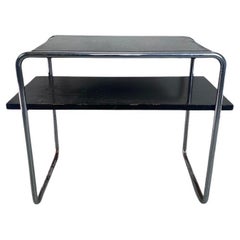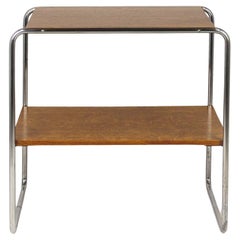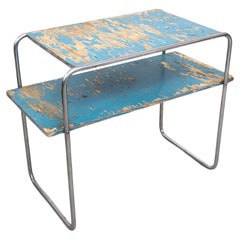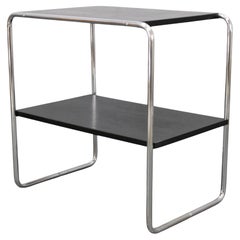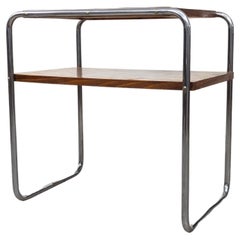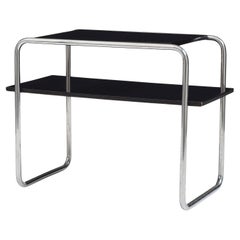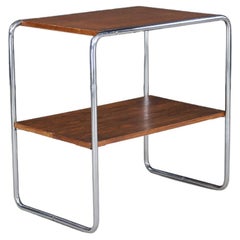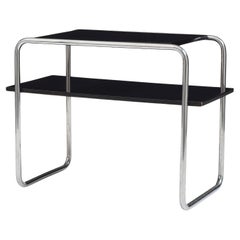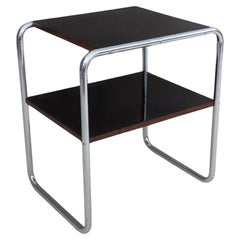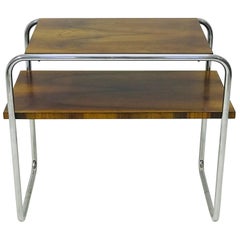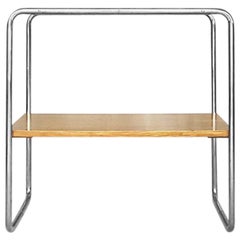Marcel Breuer B12
Vintage 1930s German Bauhaus Side Tables
Steel
Vintage 1940s Czech Bauhaus Console Tables
Steel
Vintage 1930s Czech Bauhaus Console Tables
Steel, Chrome
Mid-20th Century Czech Bauhaus Console Tables
Chrome
Vintage 1930s Czech Bauhaus Console Tables
Steel, Chrome
Vintage 1930s German Mid-Century Modern Side Tables
Metal
Vintage 1930s Czech Bauhaus Console Tables
Steel
Vintage 1930s German Mid-Century Modern Console Tables
Chrome
Vintage 1930s Czech Bauhaus Side Tables
Steel, Chrome
Recent Sales
Vintage 1920s German Bauhaus Side Tables
Chrome
Vintage 1930s European Bauhaus Console Tables
Steel, Chrome
Mid-20th Century Hungarian Side Tables
Chrome
Vintage 1940s Czech Bauhaus Console Tables
Steel
Vintage 1940s Czech Bauhaus Console Tables
Steel
Vintage 1940s European Bauhaus Console Tables
Steel, Chrome
Vintage 1940s Czech Bauhaus Console Tables
Steel
Vintage 1930s Czech Bauhaus Console Tables
Chrome, Steel
Vintage 1930s German Bauhaus Console Tables
Steel
Vintage 1930s German Bauhaus Shelves
Steel
Vintage 1940s Czech Art Deco Console Tables
Chrome
People Also Browsed
1990s American Mid-Century Modern Dining Room Tables
Steel
Mid-20th Century French Chandeliers and Pendants
Glass
2010s Italian Mid-Century Modern Stools
Wood
2010s South African Minimalist Pedestals
Wood
Vintage 1960s Italian Mid-Century Modern Chandeliers and Pendants
Metal, Copper
Vintage 1970s Italian Coffee and Cocktail Tables
Walnut
21st Century and Contemporary Italian Mid-Century Modern Wall Lights and...
Metal, Aluminum, Brass
Mid-20th Century German Bauhaus Chandeliers and Pendants
Brass
2010s Italian Art Deco Wall Lights and Sconces
Brass
2010s Lithuanian Scandinavian Modern Side Tables
Aluminum
Early 2000s Italian Mid-Century Modern Wall Mirrors
Brass
Vintage 1970s Italian Post-Modern Armchairs
Fabric, Wood, Velvet
Vintage 1970s German Mid-Century Modern Credenzas
Metal
Vintage 1960s American Posters
Paper
Early 2000s Italian Mid-Century Modern Wall Mirrors
Brass
Vintage 1950s French Mid-Century Modern Coffee and Cocktail Tables
Iron
Marcel Breuer B12 For Sale on 1stDibs
How Much is a Marcel Breuer B12?
Marcel Breuer for sale on 1stDibs
The architect and designer Marcel Breuer was one the 20th century’s most influential and innovative adherents of modernism. A member of the Bauhaus faculty, Breuer — like such colleagues as the architects Walter Gropius and Ludwig Mies van der Rohe, and the artists and art theoreticians László Moholy-Nagy and Josef Albers — left Europe in the 1930s to champion the new design philosophy and its practice in the United States.
Born in Hungary, Breuer became a Bauhaus student in 1920 and quickly impressed Gropius, the German school’s founder, with his aptitude for furniture design. His early work was influenced by the minimalist Dutch design movement De Stijl — in particular the work of architect Gerrit Rietveld.
In 1925, while he was head of the Bauhaus furniture workshop, Breuer realized his signature innovation: the use of lightweight tubular-steel frames for chairs, tables and sofas — a technique soon adopted by Mies and others. Breuer’s attention gradually shifted from design to architecture, and, at the urging of Gropius, he joined his mentor in 1937 on the faculty of Harvard and in an architectural practice.
In the 1940s, Breuer opened his own architectural office, and there his style evolved from geometric, glass-walled structures toward a kind of hybrid architecture — seen in numerous Breuer houses in New England — that pairs bases of local fieldstone with sleek, wood-framed modernist upper floors. In his later, larger commissions, Breuer worked chiefly with reinforced concrete and stone, as seen in his best-known design, the brutalist inverted ziggurat built in New York in 1966 as the home of the Whitney Museum of American Art.
Breuer’s most famous furniture pieces are those made of tubular steel, which include the Wassily chair — named after Wassily Kandinsky and recognizable for its leather-strap seating supports — and the caned Cesca chair.
Breuer also made several notable designs in molded plywood, including a chaise and nesting table for the British firm Isokon and a student furniture suite commissioned in 1938 for a dormitory at Bryn Mawr College. Whether in metal or wood, Breuer’s design objects are elegant and adaptable examples of classic modernist design — useful and appropriate in any environment.
Find vintage Marcel Breuer seating, storage cabinets and lighting on 1stDibs.
A Close Look at Bauhaus Furniture
The Bauhaus was a progressive German art and design school founded by the architect Walter Gropius that operated from 1919 to 1933. Authentic Bauhaus furniture — sofas, dining chairs, tables and more — and the school’s followers married industrial and natural materials in simple, geometric forms. The goal of the Bauhaus was to erase the distinction between art and craft while embracing the use of new technologies and materials.
ORIGINS OF BAUHAUS FURNITURE DESIGN
- Art and design school established in Germany in 1919
- Promotion of a union of art, craft and technology
- Design intended for mass production
- School’s workshops focused on cabinetry, metalworking, typography, textiles and more
- Informed by De Stijl, Constructivism, Art Nouveau, Arts and Crafts, and modernism; influenced mid-century modernism, Scandinavian modernism
CHARACTERISTICS OF BAUHAUS FURNITURE DESIGN
- Emphasis on craft
- Simplicity, order, clarity and a prioritization of functionalism
- Incorporation of geometric shapes
- Minimalist and refined, little to no ornamentation
- Use of industrial materials such as tubular chrome, steel and plastic as well as leather, cane and molded plywood in furniture and other products
BAUHAUS FURNITURE DESIGNERS YOU SHOULD KNOW
- László Moholy-Nagy
- Ludwig Mies van der Rohe
- Anni Albers
- Josef Hoffmann
- Marcel Breuer
- Marianne Brandt
AUTHENTIC BAUHAUS FURNITURE ON 1STDIBS
The name Bauhaus is derived from the German verb bauen, “to build.” Under the school’s innovative curriculum, students were taught the fine arts, such as painting and sculpture, as well as practical skills like carpentry and metalworking.
The school moved from Weimar in 1925 to the city of Dessau, where it enjoyed its heyday under Gropius, then Hannes Meyer and Ludwig Mies van der Rohe. The period from 1932 to 1933 when it operated in Berlin under Mies was its final chapter. Despite its brief existence, the Bauhaus has had an enduring impact on art and design in the United States and elsewhere, and is regarded by many as the 20th century’s chief crucible of modernism.
The faculty roster at the Bauhaus reads like a who’s who of modernist creative genius — it included such artists as Paul Klee, Wassily Kandinsky and László Moholy-Nagy along with architects and designers like Mies and Marcel Breuer, who became known for his muscular brutalist-style concrete buildings in the postwar years. In 1925, while he was head of the Bauhaus carpentry workshop, Breuer gave form to his signature innovation: the use of lightweight tubular-steel frames for chairs, side tables and sofas — a technique soon adopted by Mies and others. Breuer’s Cesca chair was the first-ever tubular steel frame chair with a caned seat to be mass produced, while the inspiration for his legendary Wassily chair, a timeless design and part of the collection crafted to furnish the Dessau school, was the bike he rode around campus.
Bauhaus design style reflects the tenets by which these creators worked: simplicity, clarity and function. They disdained superfluous ornament in favor of precise construction. Seating pieces such as side chairs, armchairs or club chairs for example, were made with tubular metal or molded plywood frames, and upholstery was made from leather or cane. Above all, designs in the Bauhaus style offer aesthetic flexibility. They can be the elements of a wholly spare, minimalist space, the quiet foundation of an environment in which color and pattern come from one’s own collection of art and artifacts.
Today, from textiles to typefaces, architecture, furniture and decorative objects for the home, Bauhaus creations continue to have an outsize influence on modern design.
Find a collection of authentic Bauhaus furniture on 1stDibs.
Finding the Right Tables for You
The right vintage, new or antique tables can help make any space in your home stand out.
Over the years, the variety of tables available to us, as well as our specific needs for said tables, has broadened. Today, with all manner of these must-have furnishings differing in shape, material and style, any dining room table can shine just as brightly as the guests who gather around it.
Remember, when shopping for a dining table, it must fit your dining area, and you need to account for space around the table too — think outside the box, as an oval dining table may work for tighter spaces. Alternatively, if you’ve got the room, a Regency-style dining table can elevate any formal occasion at mealtime.
Innovative furniture makers and designers have also redefined what a table can be. Whether it’s an unconventional Ping-Pong table, a brass side table to display your treasured collectibles or a Louis Vuitton steamer trunk to add an air of nostalgia to your loft, your table can say a lot about you.
The visionary work of French designer Xavier Lavergne, for example, includes tables that draw on the forms of celestial bodies as often as they do aquatic creatures or fossils. Elsewhere, Italian architect Gae Aulenti, who looked to Roman architecture in crafting her stately Jumbo coffee table, created clever glass-topped mobile coffee tables that move on bicycle tires or sculpted wood wheels for Fontana Arte.
Coffee and cocktail tables can serve as a room’s centerpiece with attention-grabbing details and colors. Glass varieties will keep your hardwood flooring and dazzling area rugs on display, while a marble or stone coffee table in a modern interior can showcase your prized art books and decorative objects. A unique vintage desk or writing table can bring sophistication and even a bit of spice to your work life.
No matter your desired form or function, a quality table for your living space is a sound investment. On 1stDibs, browse a collection of vintage, new and antique bedside tables, mid-century end tables and more .
- What is Marcel Breuer known for?1 Answer1stDibs ExpertMarch 22, 2022Marcel Breuer is known for his work as an architect and furniture designer during the 20th century. During his life, he created many famous chairs that remain popular today, including the Wassily lounge chair, the Cesca chair and the D40 cantilever chair. You’ll find a range of Marcel Breuer furniture on 1stDibs.
